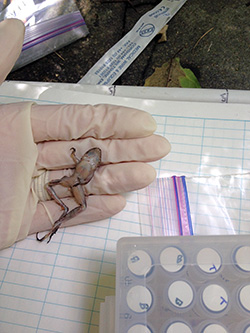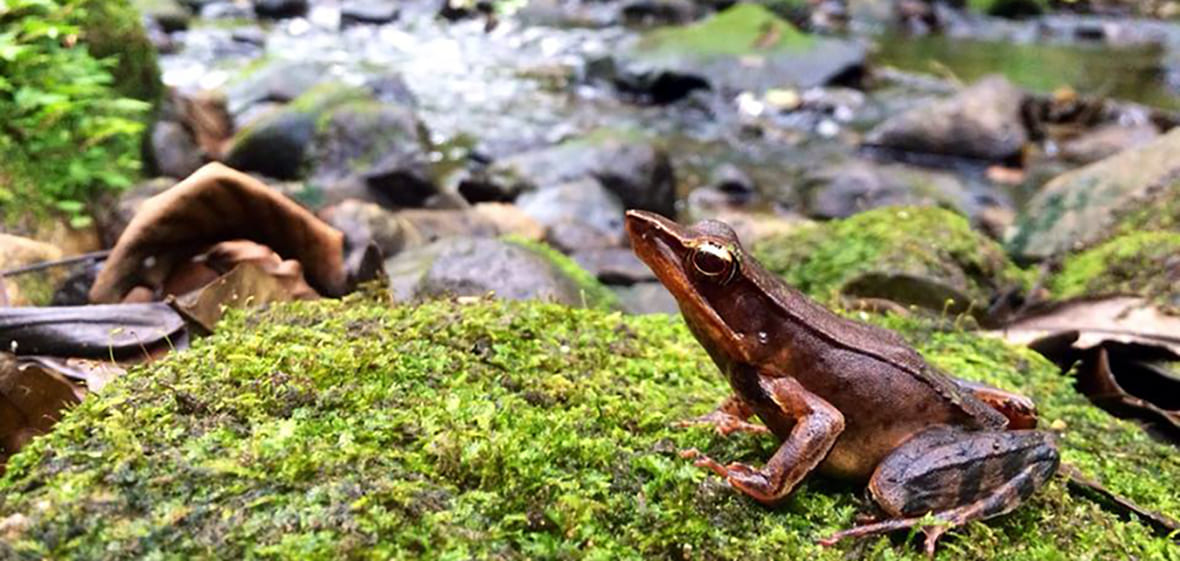An international study led by The Australian National University has found that a fungal disease has caused dramatic population declines worldwide in at least 501 amphibian species, including 90 extinctions, over the past 50 years.
As a co-author of the study published in the journal Science, Jamie Voyles of the University of Nevada, Reno provided scientific data for Central America.
"This involved many years of field research and data collection on amphibians in the tropical rainforests of Panama," she said. "The data our lab provided was key to understanding the disease dynamics in this corner of the world."
The disease, which eats away at the skin of amphibians, has completely wiped out some species, while causing more sporadic deaths among other species. Amphibians, which commonly live part of their life in water and the other part on land, mainly consist of frogs, toads and salamanders.
The deadly disease, chytridiomycosis, is present in more than 60 countries - the worst affected parts of the world are Australia, Central America and South America.

Voyles' work encompasses toads, salamanders, and the unusual and little known Caecilians, which is a legless eyeless amphibian that lives primarily underground, are very secretive and hard to find. She's been working in the Panama region since 2003, visiting twice a year in the summer (dry season) and the winter (wet season) studying and cataloguing the amphibians.
"Only a small percentage of the impacted species show signs of recovery from the disease," she said. "For the rest of them, it‘s challenging to say if they are extinct - if we can't see it we can't conclude - but we know a high number have suffered severe declines and are either threatened or extinct in Panama due to the disease."
Voyles, who received her doctorate from James Cook University in Australia and completed a couple of post-doctoral assignments before coming to the College of Science at the University of Nevada, Reno in 2015, is one of 41 different amphibian and wildlife disease experts from around the world collaborating on this global look at amphibian populations.
The researchers found that chytridiomycosis is responsible for the greatest loss of biodiversity due to a disease. The disease is caused by chytrid fungus, which likely originated in Asia where local amphibians appear to have resistance to the disease.
The unprecedented number of declines places chytrid fungus among the most damaging of invasive species worldwide, threatening similar numbers of species, such as rats and cats. Lead researcher Ben Scheele said highly virulent wildlife diseases, including chytridiomycosis, were contributing to the Earth's sixth mass extinction.
"The disease we studied has caused mass amphibian extinctions worldwide. We've lost some really amazing species," Scheele, from the Fenner School of Environment and Society at ANU, said.
He said more than 40 frog species in Australia had declined due to this disease during the past 30 years, including seven species that had become extinct.
"Globalization and wildlife trade are the main causes of this global pandemic and are enabling disease spread to continue," he said. "Humans are moving plants and animals around the world at an increasingly rapid rate, introducing pathogens into new areas."
Scheele said improved biosecurity and wildlife trade regulation were urgently needed to prevent any more extinctions around the world.
"We've got to do everything possible to stop future pandemics, by having better control over wildlife trade around the world," he said."
Scheele said the team's work identified that many impacted species were still at high risk of extinction over the next 10 to 20 years from chytridiomycosis due to ongoing declines.
"Knowing what species are at risk can help target future research to develop conservation actions to prevent extinctions."
Conservation programs in Australia had prevented the extinction of frog species and developed new reintroduction techniques to save some amphibian species.
"It's really hard to remove chytrid fungus from an ecosystem - if it is in an ecosystem, it's pretty much there to stay, unfortunately," he said. "This is partly because some species aren't killed by the disease.
"On the one hand, it's lucky that some species are resistant to chytrid fungus; but on the other hand, it means that these species carry the fungus and act as a reservoir for it so there's a constant source of the fungus in the environment, he said.
Co-researcher Claire Foster, who is also from the Fenner School of Environment and Society, said the ANU-led study involved collaborations with 41 different amphibian and wildlife disease experts from around the world.
"These collaborators enabled us to get first-hand insight into what has been happening on the ground in those countries," she said.
This paper's abstract on sciencemag.org can be found at the following URL: http://science.sciencemag.org/cgi/doi/10.1126/science.aav0379.












